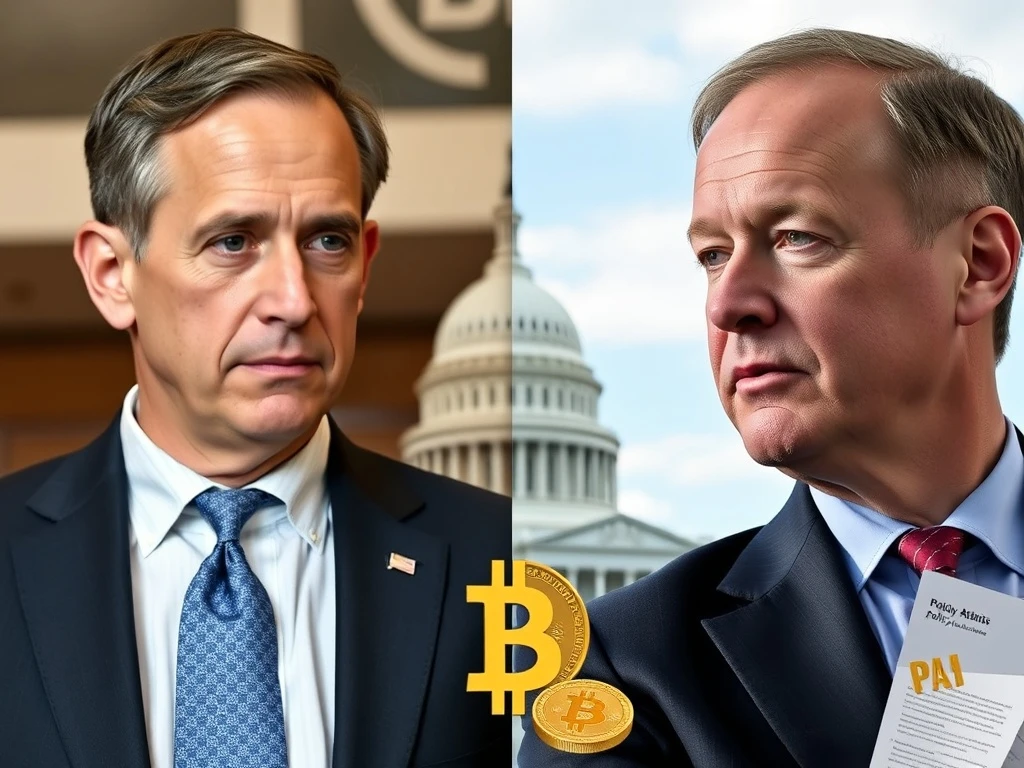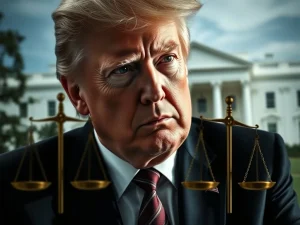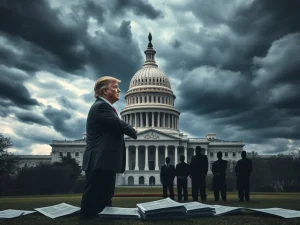Gary Gensler’s Controversial Legacy: SEC Crypto Undergoes Seismic Policy Shift

The landscape of cryptocurrency regulation in the United States faces a pivotal moment. Recent developments at the Securities and Exchange Commission (SEC) signal a significant departure from past approaches. This shift comes as former SEC Chair Gary Gensler defends his tenure, even as the agency under President Donald Trump‘s administration embarks on a new path. Understanding these contrasting philosophies is crucial for anyone involved in the digital asset space.
Gary Gensler’s Unwavering Stance on SEC Crypto Enforcement
Former SEC Chair Gary Gensler recently addressed his four years at the helm of the agency. He expressed no regrets about his approach to crypto enforcement. In a Wednesday interview with CNBC’s Sara Eisen, Gensler responded to questions about the current SEC leadership. Eisen highlighted that the agency under Paul Atkins was “reversing a lot of what [he] did.” She also noted that many investors were “ecstatic” about his departure.
Gensler, however, remained steadfast. He stated his pride in his time at the SEC. He believed he made the correct decisions regarding digital asset regulation. Furthermore, he reiterated his long-held view that crypto remains a “highly speculative, very risky asset.” His primary focus, he explained, was always investor protection. “We were consistently trying to ensure for investor protection,” Gensler affirmed. He pointed to instances of fraud during his tenure, citing Sam Bankman-Fried as an example. “And in the midst of it, we had a lot of fraudsters: Look at Sam Bankman-Fried, and he wasn’t alone,” Gensler added.
During his leadership, Gensler pursued a strategy often termed “regulation by enforcement.” This approach led to numerous lawsuits against prominent crypto companies. Critics argued this method stifled innovation and lacked clear guidelines. Conversely, proponents maintained it was necessary to protect consumers in an unregulated market. Gensler’s consistent message emphasized the need for existing securities laws to apply to digital assets. This created a contentious environment within the crypto industry. Many firms found themselves navigating legal challenges without explicit regulatory frameworks.
The Trump Administration’s Radical Crypto Regulation Shift
Gary Gensler departed the SEC on January 20, the day Donald Trump took office. During his 2024 campaign, Trump had famously threatened to fire Gensler “on day one” if elected. Gensler subsequently returned to a teaching position at the MIT Sloan School of Management. His exit marked the beginning of a significant policy overhaul at the SEC concerning digital assets.
The agency under Trump has indeed radically changed its approach. This represents a stark contrast to Gensler’s tenure from 2021 to 2025. His period coincided with a major crypto market downturn. It also saw massive fraud through FTX and numerous company bankruptcies. The new leadership, however, has adopted a different philosophy. Key changes include:
- Dropped Lawsuits: Acting SEC Chair Mark Uyeda, before Paul Atkins‘ Senate confirmation, directed the dropping of several lawsuits and investigations against crypto companies. This provided relief to many in the industry.
- Reassessment of Securities Status: The agency’s leadership has stated that “very few tokens are securities.” This declaration offers a more lenient interpretation than Gensler’s broad application of securities laws.
- Streamlined ETF Approvals: The SEC introduced streamlined listing standards for cryptocurrency exchange-traded fund (ETF) approvals. This move could pave the way for broader institutional adoption of digital assets.
These actions signal a more accommodating stance towards the crypto industry. They suggest a desire to foster innovation rather than solely focusing on enforcement. Many in the crypto community welcome these changes. They view them as essential for the sector’s growth and integration into mainstream finance. Consequently, the industry anticipates a more predictable regulatory environment.
Donald Trump’s Vision for Corporate Reporting Standards
Beyond crypto-specific policies, President Donald Trump proposed a potentially significant policy change affecting all US companies. On Monday, Trump stated that the SEC should abandon its quarterly reporting requirements. Instead, he suggested shifting to a twice-a-year model. This proposal aims to reduce the burden on public companies. It also seeks to encourage long-term investment strategies.
The rationale behind Trump’s proposal centers on easing regulatory pressures. Many companies argue that quarterly reports are costly and time-consuming. They also believe these frequent reports can lead to a short-term focus among investors. A semi-annual reporting model, therefore, could allow companies to focus more on strategic growth. It might also reduce market volatility driven by short-term earnings expectations. This change, if implemented, would represent a fundamental shift in corporate governance. It would impact how investors receive information and make decisions.
Navigating the New Era with Paul Atkins
Current SEC head Paul Atkins addressed President Trump’s proposal for corporate reporting. On Friday, Atkins indicated that the SEC would “consider that and move forward” after a proposed rule change. His comments suggest an openness to evaluating the feasibility and impact of such a shift. Atkins emphasized a market-driven approach to reporting cadence. “For the sake of shareholders and public companies, the market can decide what the proper cadence is,” Atkins remarked. He believes that if investors desire to maintain quarterly reports, they must voice their opinions.
Atkins’ stance reflects a philosophy that prioritizes market efficiency and corporate autonomy. This contrasts with Gensler’s more interventionist regulatory style. The new SEC leadership appears keen to empower market participants. They aim to let these participants determine appropriate reporting frequencies. This approach could lead to a more flexible regulatory landscape. It would allow companies to tailor their disclosure practices to their specific needs. Ultimately, the decision will involve extensive public comment and analysis. It will balance investor information needs with corporate operational burdens.
The Future Landscape of US Crypto Regulation
Gary Gensler also weighed in on the proposed change to corporate reporting. He expressed concerns about the potential impact on market transparency and volatility. “For me, I think transparency helps markets,” Gensler stated on Wednesday. He argued that reducing reporting frequency could have negative consequences. “If we go to only twice a year instead of four times a year reporting, the markets will be a bit more volatile,” he predicted. Gensler’s perspective highlights the importance of timely information for informed investment decisions. He believes frequent disclosures are vital for maintaining market integrity and investor confidence.
The contrasting views of Gensler and the current SEC leadership underscore a broader ideological divide. This divide concerns the role of regulation in financial markets. Gensler champions robust oversight and frequent disclosures. He sees them as essential for investor protection and market stability. Conversely, the Trump administration and Atkins advocate for less intrusive regulation. They believe this approach fosters economic growth and innovation. The ongoing debate about crypto regulation, corporate reporting, and the SEC’s overall mandate will continue to shape the financial landscape. Stakeholders across the crypto industry and traditional finance are closely watching these developments. The ultimate direction of these policies will have lasting implications for investors, companies, and the broader economy.
Ultimately, the regulatory environment for digital assets remains dynamic. The shift from Gensler’s enforcement-heavy approach to a more accommodating stance under the Trump administration signals a new chapter. Investors and companies must stay informed. These policy changes will undoubtedly influence market behavior and investment strategies. The dialogue between past and present SEC leaders reveals fundamental differences. These differences will continue to define the future of finance.










